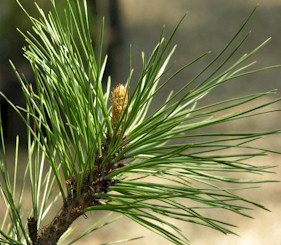Botanical Discoveries:
Ponderosa Pine (Pinus ponderosa)
Canoe Camp, near the mouth of
the North Fork of the Clearwater River in Clearwater County, Idaho on October
1, 1805
Named Montana State tree in
1949, this eastern variety of the vanilla-scented pine was noted by Lewis
and Clark. Native Peoples have long honored
Ponderosa Pine (Pinus
ponderosa) as a staple for
basketry material, using the pitch as an adhesive, eating the nuts from the
cones and the young inner bark. It's beauty is valued for landscaping,
lending itself to many different styles.
|
 |
|
|
The Expedition's Journey
Continues:
Our weather here in the Willamette Valley has been
much like the explorers are experiencing. Yesterday we had a little
rain, some pretty strong winds and a sunny afternoon. Two days ago the
morning was chill, no frost yet but it's not far away. But today is
dawning clear and warm, almost balmy.
The wind blew all night from the N.W. Some
rain. We were obliged to drop down 3 miles to get the channel
sufficiently deep to pass up. Several Indians on the shore viewing of
us, called to us to land. One of them gave 3 yells and skipped a ball
before us. We paid no attention to him. Proceeded on and came to on the
L.S. to breakfast. One of those Indians swam across to us, begged for
powder. We gave him a piece of tobacco, and set him over on a sand bar,
and set out. The wind hard ahead. Passed an island in the middle of the
river about 3 miles in length, we call Good Hope Island. At 4 miles,
passed a creek on the L.S. about 12 yards wide. Captain Lewis and 3 men
walked on shore, and crossed over to an island situated on the S.S. of
the current, and near the center of the river. This island is about 1
1/2 miles long and nearly half as wide. In the center of this island was
an old village of the Arikaras, called Lahoocatt. It was circular and
walled, containing 17 lodges, and it appears to have been deserted about
five years. The island contains but little timber. We camped on the sand
bar making from this island. The day very cool.
Captain Clark, 4 October 1804
Frost this morning. We set out early and
proceeded on. Passed a small creek on the L.S. At 7 o'clock heard some
yells. Proceeded on. Saw three Indians of the Teton band. They called to
us to come on shore. Begged some tobacco. We answered them as usual and
proceeded on. Saw a gang of goats [antelope] swimming across the river,
out of which we killed four. They were not fat. We came to and camped on
a mud bar making from the S.S. The evening is calm and pleasant.
Refreshed the men with a glass of whiskey.
Captain Clark, 5 October 1804
If you're ever fortunate enough to see a herd of
antelope, think of Captain Clark's description (a gang of goats) and
smile.
Go to our Corps of Discovery Expedition
Bicentennial Index page
to see all links in this series. Or click
here
to go directly to the next installment of our
journey.
|
 |
|
Bringing history alive: The Corps vs. the Tetons
In addition to scientific exploration, the expedition had
the political agenda of making treaties with the Indian
tribes previously beyond United States influence. President
Jefferson had told Lewis that the Teton Sioux were the
people in the area who were most dangerous and influential.
Jefferson writes, in reference to the Teton Sioux, “On that
nation we wish most particularly to make a favorable
impression.”
However, Lewis and Clark lacked a competent interpreter,
disregarded the importance the Teton Sioux placed on their
control of trade, and had little patience for the pride of
the Native warriors. Only Black Buffalo's cool head saved
the situation when the groups finally met in 1804.
At the first council with the leaders of the Teton
tribe, the expedition went through its practiced ritual
for meeting Indians, parading in uniform and
demonstrating an air gun. The display did little to
impress the Tetons, who perceived the Americans as
competitors for control of trade in the region. Tensions
increased between the two sides, nearly resulting in an
armed conflict. Fortunately, the Teton chief Black
Buffalo intervened and brought things back to a more
diplomatic level.
|
Sitting Bull, 1831 - 1890,
one of the most
famous chiefs of the Teton Sioux, was born after the
expedition concluded.

"Every seed is awakened and so
is all animal life. It is through this mysterious power that
we too have our being and we therefore yield to our animal
neighbours the same right as ourselves, to inhabit this
land."
|
Over the following three days,
the Tetons hosted the Corps, though the expedition kept
its keelboat anchored almost a mile away. During the
Corps’ stay, Clark made detailed notes of Teton culture.
In his journal, the Tetons are described as thin, small
and generally ill-looking. Teton men wore hawk feathers
about their heads and robes over their bodies, while
women dressed in buffalo skins and robes. During the
expedition’s stay, the Tetons held a number of
celebrations – scalp dances – of a recent war victory
over the rival Omahas.
A number of confrontations
between the Tetons and the expedition brought the
Americans visit to an end. No one in the Corps of
Discovery spoke Sioux, and the inability of the two
groups to communicate effectively played a significant
part in several misunderstandings. After another
argument between the Tetons and the expedition nearly
escalated into fighting, Lewis and Clark continued
upriver.
www.pbs.org/lewisandclark/native/tet.html
|
|